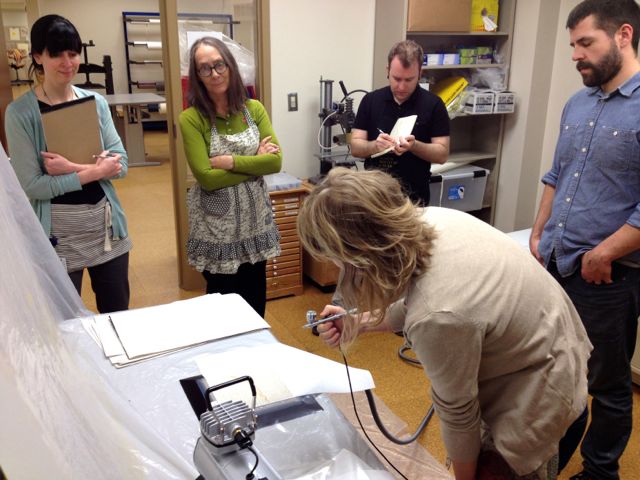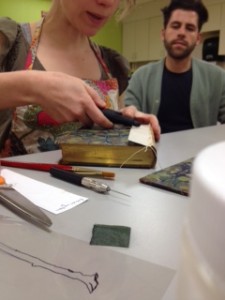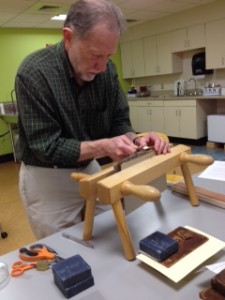Every now and then we take some time to practice new techniques we learn at conferences and workshops. At the 2015 AIC Annual Conference, Erin learned how to use an airbrush and how it could be applied to conservation. Last week she showed us what she learned, and gave us all time to practice with the airbrush. Erin has experimented with tide line removal and tissue toning with the airbrush. We brainstormed other ways we could use this method, too, including consolidation and perhaps spot washing on the suction platen. Have you used an airbrush in your lab? Let us know in the comments how and to what effect.
Category Archives: Training
Preservation of a Different Kind
This post is only slightly off topic, but it is preservation related of a kind. Our University Archivist and myself went over to Duke Hospital to take part in a compression-only CPR class today. This session focused on what to do if an adult or teenager collapses due to cardiac arrest.
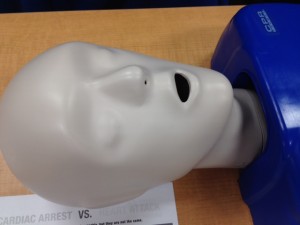
We learned the proper way to apply compressions following the “three C’s.”
- Check to see if the person is conscious
- Call 911; and if there is an AED in your building, ask someone to get that, or get it yourself
- Compressions at at least 100 beats per minute
If you need help keeping the 100 beats-per-minute rhythm, the American Heart Association has put together a Spotify list of music with the perfect beat to do CPR compressions. We also learned how to use an Automated External Defibrillator or AED, which led me to wonder if the library has one. I’ve sent an email to our building security manager to find out.
There is a very brief video by the American Heart Association that demonstrates the compression-only CPR technique.* You do not need to be certified to do this method of CPR, and it does not involve checking for a heart beat, sweeping the mouth, or providing breaths.

At the beginning of the class we were asked to share this information with eight people, and ask them to share as well. Consider yourself part of my eight people. Now go and share!
*A Facebook reader sent us this link to the British Heart Association’s compression-only CPR video with Vinnie Jones. Very funny.
Photo Conservation Workshop: Wrap Up
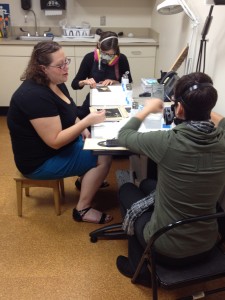
We are all still talking about the shear amount of information we learned last week at “Photo Conservation for Book and Paper Conservators,” taught by Gawain Weaver and Jennifer Olsen of Gawain Weaver Art Conservation.
Colleagues from across the country came to the Verne and Tanya Roberts Conservation lab for this event. We had people from California, Colorado, Iowa, Kansas, New York, Minnesota, and of course several from the Raleigh-Durham-Chapel Hill area (Duke, UNC Chapel Hill and the NC State Archives). Some work in university libraries and archives, others in private practice, and some in other types of organizations. It was a great mix of experiences and perspectives.
This workshop was geared toward mid-career conservators who already have a fundamental understanding of materials and solvents, experience in evaluating the condition of materials, and experience in making treatment decisions. The goal was to give paper and book conservators hands-on experience working with various historic and modern photographic processes and to get us more comfortable in doing so.

Gawain and Jennifer are very generous teachers. They use a good mix of demonstration, hands-on practicums and lectures to get the information across. We were also able to work with samples of actual photographs, which helped move theory into practice. We learned about removing silver mirroring, removing photos stuck to glass, attaching and removing heat set tissue, and various methods of mechanical and chemical surface cleaning. We also discussed disaster recovery, mold removal, humidifying and flattening, housing options, and general mending.

We participated because so much of our photographic collections are valued primarily for their informational content, not their artistic value (although that isn’t always the case). Therefore, they do not rise to the level that would trigger sending them out for treatment. Yet, some of our photos need more treatment than simply housing. I think we all came away with a better understanding of what we can do even though photographs are not are area of expertise.
What I value most about last week is the camaraderie of professionals learning from each other; meeting new colleagues and working with long-time friends; being treated professionally by people outside your specialty; learning skills that would otherwise be difficult to learn; and walking away knowing more about when you should and shouldn’t undertake treatment. I also enjoyed the parts that began with the caveat, “You would never do this with real objects, but watch what happens when you do!”
We have posted images from the workshop on Flickr, and you can see composites and a brief description of Day 1, Day 2, Day 3, and Day 4 on Preservation Underground. Check out Melissa Tedone’s review of the week on Parks Library Preservation.
Photo Conservation Workshop: Day 4
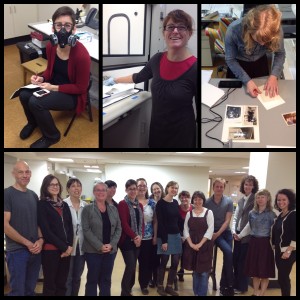
Last day of class and we are knee deep in attaching and removing various heat set tissues. We removed them mechanically with a variety of implements, and attempted to remove them chemically with varying success. I have a feeling some of these were successful only because they haven’t been sitting in an attic or outbuilding for 50 years. Maybe some artificial aging of the samples is in order.
Thanks to the Nasher Museum for lending us their heat set press. We wouldn’t have been able to do any of the last day without it.
Addendum: We have posted images from the workshop on Flickr, and you can see composites and a brief description of Day 1, Day 2, Day 3, and Day 4 on Preservation Underground.
Photo Conservation Workshop: Day 3

Day 3 of photo conservation for book and paper conservators was incredibly busy. We learned about platinum prints, then got to work experimenting on a variety of color print technologies. We tried tape removal techniques and played “what would happen if…?” by cutting up color prints and immersing them in various solvents. The sounds coming from the fume hood were similar to those at a fireworks show.
We ended the day learning about a brief history of cold-press and heat-set tissues, and prepped for today’s session of sticking photos to things and unsticking them from things.
Addendum: We have posted images from the workshop on Flickr, and you can see composites and a brief description of Day 1, Day 2, Day 3, and Day 4 on Preservation Underground.
Photo Conservation Workshop: Day 2

On Day 2 of the photo conservation workshop we concentrated on silver gelatin prints. We learned how to dry clean surfaces, a couple techniques for removing silver mirroring, and attempted to remove prints that were stuck to glass.
One of the best things about workshops like this is learning tips from each other, and learning that when you find things difficult it may not be your skills that are faulty. It may be that the treatment is difficult even for very skilled professionals and almost always leads to heartbreak [see also: removing prints stuck to glass].
Addendum: We have posted images from the workshop on Flickr, and you can see composites and a brief description of Day 1, Day 2, Day 3, and Day 4 on Preservation Underground.
Photo Conservation Workshop: Day 1

Day one of “Photo Conservation for Book and Paper Conservators” was incredibly informative. Tuesday we learned some basic early silver print history and manufacture, and how to dry- and wet-clean albumen prints.
The class is made up of conservators from all over the country, in private practice, libraries and archives. It’s fun to study with long-time friends and to meet new colleagues. We are looking forward to day two.
By the way, Beth Heller (Beth Heller Conservation) and Melissa Tedone (Parks Library Preservation) are here. Check out their blogs for highlights from the workshop.
Addendum: We have posted images from the workshop on Flickr, and you can see composites and a brief description of Day 1, Day 2, Day 3, and Day 4 on Preservation Underground.
Upcoming NCPC Conference: Significant Preservation: Inventories and Assessments for Strategic Planning
From the NCPC Press release:
Significant Preservation: Inventories and Assessments for Strategic Planning
North Carolina Preservation Consortium Annual Conference
William and Ida Friday Center for Continuing Education
University of North Carolina at Chapel Hill
November 7, 2014
Inventories and assessments of heritage collections and sites are vital for meaningful strategic planning that conveys the importance of allocating scarce resources for preservation programs. Establishing the significance of tangible heritage to the communities we serve is essential for prioritizing conservation, storage, exhibition, and emergency planning decisions to protect cultural treasures for present and future generations. This conference will help you influence organizational, political, and community leaders who have the authority to improve preservation funding. Register today for a valuable learning experience with state, national, and international preservation leaders.
Keynote Speakers
Veronica Bullock is the Co-founder and Director of Significance International. She holds a bachelor’s degree in Prehistory/Archaeology from the Australian National University and a master’s degree in Applied Science (Materials Conservation) from the University of Western Sydney. Her fellowship at the International Center for the Study of the Preservation and Restoration of Cultural Property explored how significance assessments and risk assessments are taught in graduate conservation programs in Australia, Canada, the United States, and several countries in Europe. Ms. Bullock will provide an overview of the Significance Assessment methodology developed by the Collections Council of Australia.
Lisa Ackerman is the Executive Vice President and Chief Operating Officer of the World Monuments Fund and a Visiting Assistant Professor at the Pratt Institute. She holds a BA from Middlebury College, an MS in historic preservation from the Pratt Institute, and an MBA from New York University. Her professional service has included membership on the boards of the Historic House Trust of New York City, New York Preservation Archive Project, St. Ann Center for Restoration and the Arts, Partners for Sacred Places, Neighborhood Preservation Center, and the U.S. National Committee of the International Council on Monuments and Sites. Ms. Ackerman will present an introduction to the Arches heritage inventory and management system.
Dr. Paul R. Green is a Cultural Resources Specialist for the U.S. Air Force Civil Engineer Center, an Adjunct Associate Professor at Old Dominion University, and a modern Monuments Man. He holds a BS from Marshall University, MA from the University of Missouri-Columbia, and a PhD in Anthropology (Archaeology) from the University of North Carolina at Chapel Hill. Dr. Green is a member of the U.S. Central Command (CENTCOM) Historical/Cultural Advisory Group and the International Military Cultural Resources Working Group. He will address the challenges and importance of prioritizing global heritage collections and sites for the protection of cultural property during war and armed conflicts.
Lightening Session Speakers
Martha Battle Jackson is Chief Curator for North Carolina Historic Sites. She will provide an overview of the Museum Assessment Program (MAP) for Collection Stewardship sponsored by the American Alliance of Museums.
Andrea Gabriel is Outreach & Development Coordinator for the North Carolina State Archives. She will present an introduction to the Traveling Archivist Program (TAP) administered by the North Carolina Office of Archives & History.
David Goist is a painting conservator in private practice. He will give an overview of the Conservation Assessment Program (CAP) sponsored by Heritage Preservation.
For more information on the conference schedule, registration, scholarships, etc., see the NCPC events page.
“Experiment Day”–A New Way to Learn
As you know, we like to stop our production work every now and then to learn something new. In June we sent representatives to both the American Institution for Conservation and the Canadian Association for Conservation annual meetings.
This was the first year we sent someone to the CAC conference. Grace attended and brought back information including an interesting use of magnets to hang a traveling exhibit of vary large artwork. What she liked most about the CAC conference is that the specialties do not break up into separate sessions like we do at AIC.

Erin and I discussed the sessions we attended at AIC including the Book and Paper Group Tips Session (always a favorite). Erin had the great idea to have an “Experiment Day” to try some of these tips. She worked with Rachel to get supplies and organize a few of the tips that seemed most useful. Rachel demonstrated a hinging technique she uses that is similar to the one Terry Marsh offered (read by Anisha Gupta) at the tips session. Erin then demonstrated other tips including a dry tear technique presented by Bill Minter, and a technique for relaxing lined artwork presented by Betsy Palmer Eldridge. It was a fun way to bring back information from a conference and experiment a little to see if we can integrate some of these techniques into our workflows.

Learning Together: Leather Repair Tips and Tricks
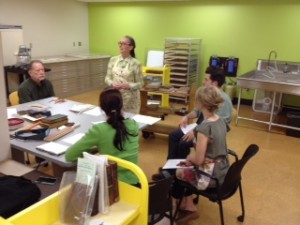 So much of what we know as conservators is based on learning at the elbow of someone else. Discovering the perfect tip or trick is immensely valuable and can mean the difference between an elegant repair and one that is “good enough.”
So much of what we know as conservators is based on learning at the elbow of someone else. Discovering the perfect tip or trick is immensely valuable and can mean the difference between an elegant repair and one that is “good enough.”
This week we held an extended in-house workshop covering several types of leather repair techniques: headcap repair, Etherington tissue hinge, Brock split hinge repair, tacketing and rebacking. Our colleague, Craig Fansler, came up from Wake Forest University to learn along side us.
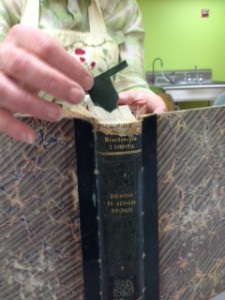
Mary demonstrated reconstructing damaged leather headcaps. This repair needs to not only look good, but it needs to function well and stand up to the flexing of the spine. Mary is very skilled at making these repairs, so she showed us her tips on creating well integrated and beautiful replacement headcaps.
Along the way we discussed the benefits of various adhesives and how to maximize their working properties to achieve the desired outcome.
Erin demonstrated the Etherington tissue hinge, tacketing, the Brock split linen hinge, and rebacking with leather. She showed us some of her prior rebacks to help us understand what the end result should look like, and had models for each of the repairs so we could see those as well. We discussed the benefits and detractions of each repair and why we would select one type of repair over another.
The most important tips we learned during our session were
- Selection is key to a successful repair, and
- Repairs should be done in stages and allowed to dry in between each stage. Going slowly and deliberately will lead to better decisions and a better final product.
I am very grateful to have such talented colleagues who are willing to share their expertise. Through this sort of collaborative training we can learn new skills and continue the tradition of passing on our knowledge. Craig has written a blog post on the Z. Reynolds Smithy blog. Be sure to check that out.


